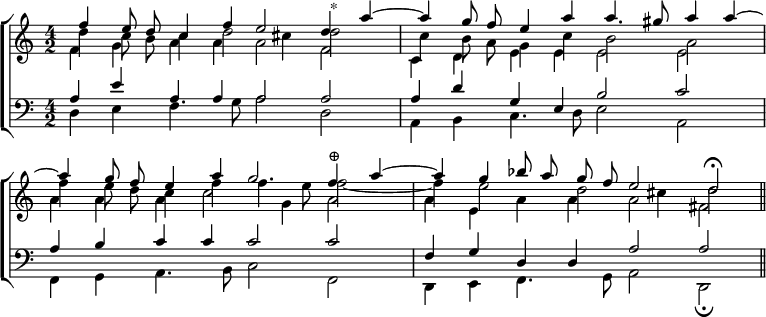A Dictionary of Music and Musicians/Ritornello
RITORNELLO (Abbrev. Ritornel, Ritor.; Fr. Ritournelle). I. An Italian word, literally signifying, a little return, or repetition; but more frequently applied, in a conventional sense, (1) to a short Instrumental Melody, played between the Scenes of an Opera, or even during their action, either for the purpose of enforcing some particular dramatic effect, or of amusing the audience during the time occupied in the preparation of some elaborate 'Set-Scene'; or, (2) to the symphonies introduced between the vocal phrases of a Song, or Anthem.
1. The earliest known use of the term, in its first sense, is to be found in Peri's 'Euridice,' in connexion with a melody for 3 flutes, which, though called a 'Zinfonia' on its first appearance, is afterwards repeated under the title of 'Ritornello.' 'Euridice' was first printed at Florence in 1600, and at Venice in 1608. [For the Zinfonia, see vol. ii. of this Dictionary, p. 499.]
A similar use of the term occurs soon afterwards in Monteverde's 'Orfeo,' printed at Venice in 1609, and republished in 1615. In this work, the Overture—there called Toccata—is followed by a 'Ritornello' in 5 parts, the rhythmic form of which is immeasurably in advance of the age in which it was produced.

* At this mark, the two upper Parts cross, and remain Inverted, until the sign ⊕.
2. When Vocal Music with Instrumental Accompaniment became more extensively cultivated, the word was brought into common use, in its second sense, as applied to the Instrumental Symphonies of a Song, or other Composition for a Solo Voice. Ritornelli of this kind were freely used by Cavalli, Cesti, Carissimi, and many other Composers of the early Venetian Dramatic School, who imitated their manner. An example from Cavalli's 'Il Giasone,' will be found at page 503 of our second volume. Towards the close of the 17th century such instrumental interpolations became very common, in all styles and countries. For instance, in early editions of the Verse Anthems of Croft, Greene, and other English Composers, of the 17th and 18th centuries, we constantly find the words 'Ritornel.', 'Ritor.', or 'Rit.', printed over little Interludes, which, unknown in the more severe kind of Ecclesiastical Music, formed a marked feature in works of this particular School, frequently embodying some of its choicest scraps of Melody, as in Dr. Boyce's Anthem, 'The Heavens declare the glory of God':—

In later editions the term disappears, its place being supplied, in the same passages, by the words 'Organ,' or 'Sym.'; which last abbreviation is almost invariably found in old copies of Handel's Songs, and other similar Music, in which the Symphonies are interpolated, as often as opportunity permits, upon the line allotted to the Voice.